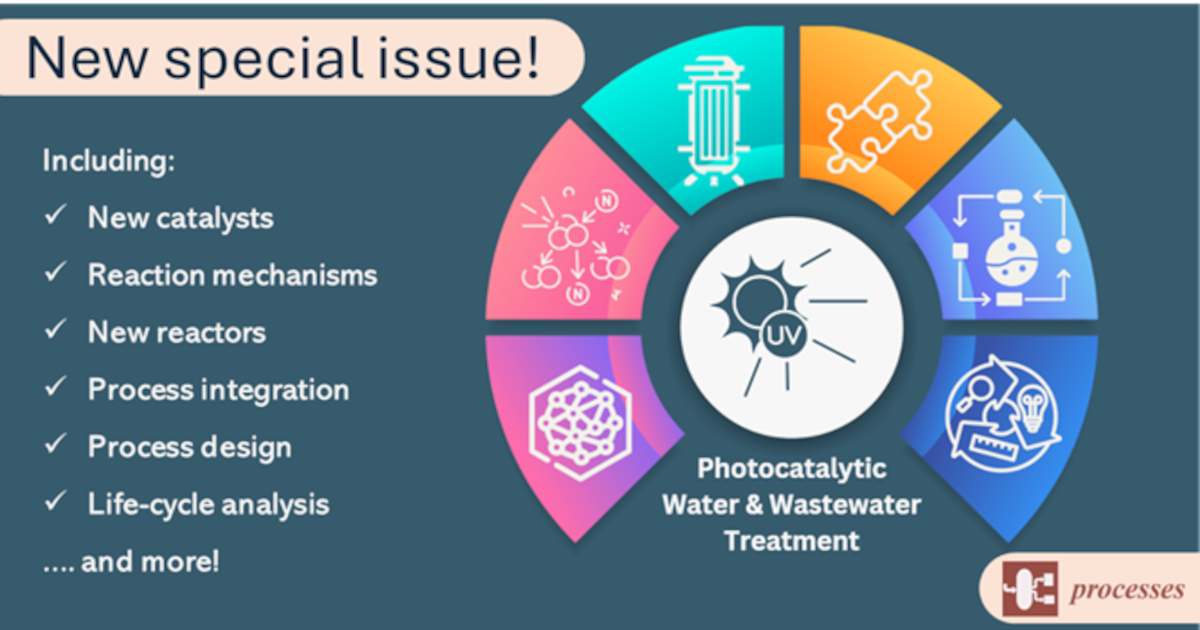- 2.8Impact Factor
- 5.5CiteScore
- 16 daysTime to First Decision
Advances in Photocatalytic Water and Wastewater Treatment Processes
This special issue belongs to the section “Catalysis Enhanced Processes“.
Special Issue Information
Dear Colleagues,
The urgency for sustainable and efficient water as well as wastewater treatment methodologies is pressing in the face of global challenges such as increasing pollution, the scarcity of clean water, and stringent environmental regulations. Photocatalytic water treatment processes represent a promising avenue for addressing these challenges due to their ability to decompose organic pollutants and inactivate microbial contaminants under light irradiation. These processes, which make use of recent advancements in materials science and catalysis, offer a green and energy-efficient alternative to conventional treatment methods. However, the field is still evolving, with significant opportunities for innovation in terms of catalyst design, reaction mechanisms, equipment design, system integration, and scalability. Understanding the complexities and optimizing the efficiencies of these processes are crucial for their practical application and the broader goal of sustainable water management.
This Special Issue on “Advances in Photocatalytic Water and Wastewater Treatment Processes” seeks high-quality works focusing on the latest developments in the field. We invite contributions that explore multidisciplinary, innovative photocatalytic materials, mechanisms, and methodologies that enhance the efficiency and applicability of water as well as wastewater treatment. Topics include, but are not limited to, the following:
- Development and characterization of novel photocatalysts for water and wastewater treatment;
- Mechanistic insights into the photocatalytic degradation of pollutants;
- Design and optimization of photocatalytic reactors as well as reaction systems;
- Integration of photocatalytic processes with other water treatment technologies;
- Pilot-scale studies on and scalability of photocatalytic water treatment processes;
- Life cycle assessments, economic analyses, and sustainability studies of photocatalytic treatment systems;
- Photocatalytic removal of emerging contaminants from water and wastewater.
We encourage contributions that provide new insights, represent significant advances, and contribute to the knowledge and application of photocatalytic water treatment processes. The findings should have implications for the design, operation, and optimization of treatment systems, aiming at the enhancement of water quality and environmental sustainability.
Dr. Bruno Ramos
Dr. Mohamed Gar Alalm
Prof. Dr. Antonio Carlos Silva Costa Teixeira
Guest Editors
Manuscript Submission Information
Manuscripts should be submitted online at www.mdpi.com by registering and logging in to this website. Once you are registered, click here to go to the submission form. Manuscripts can be submitted until the deadline. All submissions that pass pre-check are peer-reviewed. Accepted papers will be published continuously in the journal (as soon as accepted) and will be listed together on the special issue website. Research articles, review articles as well as short communications are invited. For planned papers, a title and short abstract (about 250 words) can be sent to the Editorial Office for assessment.
Submitted manuscripts should not have been published previously, nor be under consideration for publication elsewhere (except conference proceedings papers). All manuscripts are thoroughly refereed through a single-blind peer-review process. A guide for authors and other relevant information for submission of manuscripts is available on the Instructions for Authors page. Processes is an international peer-reviewed open access semimonthly journal published by MDPI.
Please visit the Instructions for Authors page before submitting a manuscript. The Article Processing Charge (APC) for publication in this open access journal is 2400 CHF (Swiss Francs). Submitted papers should be well formatted and use good English. Authors may use MDPI's English editing service prior to publication or during author revisions.
Keywords
- photocatalysis
- water treatment
- wastewater treatment
- advanced oxidation processes
- environmental remediation
- photocatalytic degradation
- photocatalytic reactors
- life cycle assessment of wastewater treatment processes
- solar-driven water treatment

Benefits of Publishing in a Special Issue
- Ease of navigation: Grouping papers by topic helps scholars navigate broad scope journals more efficiently.
- Greater discoverability: Special Issues support the reach and impact of scientific research. Articles in Special Issues are more discoverable and cited more frequently.
- Expansion of research network: Special Issues facilitate connections among authors, fostering scientific collaborations.
- External promotion: Articles in Special Issues are often promoted through the journal's social media, increasing their visibility.
- e-Book format: Special Issues with more than 10 articles can be published as dedicated e-books, ensuring wide and rapid dissemination.

